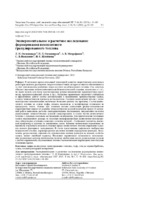| dc.contributor.author | Овчинников, Л. Н. | |
| dc.contributor.author | Овчинников, Н. Л. | |
| dc.contributor.author | Митрофанов, А. В. | |
| dc.contributor.author | Василевич, С. В. | |
| dc.contributor.author | Шпейнова, Н. С. | |
| dc.coverage.spatial | Минск | ru |
| dc.date.accessioned | 2023-02-10T07:39:35Z | |
| dc.date.available | 2023-02-10T07:39:35Z | |
| dc.date.issued | 2023 | |
| dc.identifier.citation | Экспериментальное и расчетное исследование формирования композитного гранулированного топлива = Experimental and Computational Study of the Formation of Composite Granular Fuel / Л. Н. Овчинников [и др.] // Известия высших учебных заведений и энергетических объединений СНГ. Энергетика. – 2023. – № 1. – С. 91-100. | ru |
| dc.identifier.uri | https://rep.bntu.by/handle/data/126127 | |
| dc.description.abstract | В настоящее время актуальной тенденцией развития энергетических комплексов ряда стран является расширение твердотопливной ниши, которое во многом обеспечивается за счет использования различных видов местного возобновляемого топлива. Оно зачастую обладает высокими теплотехническими свойствами (теплотой сгорания, зольностью и т. п.), но имеет низкие или плохо прогнозируемые физико-механические характеристики (прочность, гранулометрический состав и др.). Последнее практически исключает стабильную и эффективную работу систем автоматизации и механизации транспортировки гранул, а также технологические процессы котлоагрегатов. Создание композитных топлив с заданными физико-механическими свойствами позволяет решить эту проблему. Состав композитного топлива на основе торфа, опилок, целлюлозы и модификатора установлен на предыдущих этапах. Однако при заданном составе композиции физико-механические характеристики зависят от режимно-технологических условий получения гранул. В настоящей работе выполнено расчетно-экспериментальное исследование, направленное на поиск рациональных технологических условий гранулирования и сушки частиц композитного топлива с заданным массовым соотношением компонентов. Для приготовления топливных гранул определенного размера из исходных мелкофракционных компонентов использовалась лабораторная установка, основные элементы которой – Z-образный смеситель, шнековый гранулятор и сушилка со взвешенным слоем. Влияние независимых переменных на прочность и конечную влажность готовых гранул композитного топлива определено в рамках полного факторного эксперимента. В статье представлены графические изображения поверхностей отклика, характеризующие указанное влияние варьируемых факторов. Полученные регрессионные зависимости, описывающие влияние факторов на целевые свойства гранул, имеют линейный характер. Последнее ограничивает возможность использования градиентных методов оптимизации, поэтому необходимо искать рациональные условия с учетом ограничений, обусловленных технико-экономическими параметрами изготовления топливных гранул. | ru |
| dc.language.iso | ru | ru |
| dc.publisher | БНТУ | ru |
| dc.title | Экспериментальное и расчетное исследование формирования композитного гранулированного топлива | ru |
| dc.title.alternative | Experimental and Computational Study of the Formation of Composite Granular Fuel | ru |
| dc.type | Article | ru |
| dc.identifier.doi | 10.21122/1029-7448-2023-66-1-91-100 | |
| local.description.annotation | Currently, the topical trend in the development of energy complexes in a number of countries is the expansion of the solid fuel use, which is largely provided by the use of various types of local renewable fuels. The latter often have high thermal properties (heat of combustion, ash content, etc.), but have low or poorly predicted physical and mechanical characteristics (strength, granulometric composition, etc.). These circumstances practically make stable and efficient operation of automation systems, mechanization of transportation of pellets, and technological processes of boilers impossible. The formation of a composite fuel with specified physical and mechanical properties provides a solution to this problem. The structure of the composite fuel based on peat, sawdust, cellulose and modifier was established at the previous stages of our work. However, in case of a given composition, the physical and mechanical characteristics depend on the operating and technological conditions for obtaining granules. In this paper, a statistical and experimental study was carried out aimed at finding rational technological conditions for granulating and drying composite fuel particles with a given mass ratio of components. To prepare fuel pellets of a given size from the initial fine-fraction components, a laboratory installation was used, the main elements of which were a Z-shaped mixer, a screw granulator, and a fixed bed dryer. The influence of independent variables on the strength and final moisture content of finished pellets of composite fuel was determined within the framework of a full factor experiment. The paper presents graphical images of response surfaces characterizing the specified influence of variable factors. The obtained regression dependences describing the influence of factors on the target properties of granules are linear in nature. The latter limits the possibility of using gradient optimization methods and creates the need to search for rational conditions, taking into account the limitations caused by the technical and economic parameters of obtaining finished fuel pellets. | ru |

